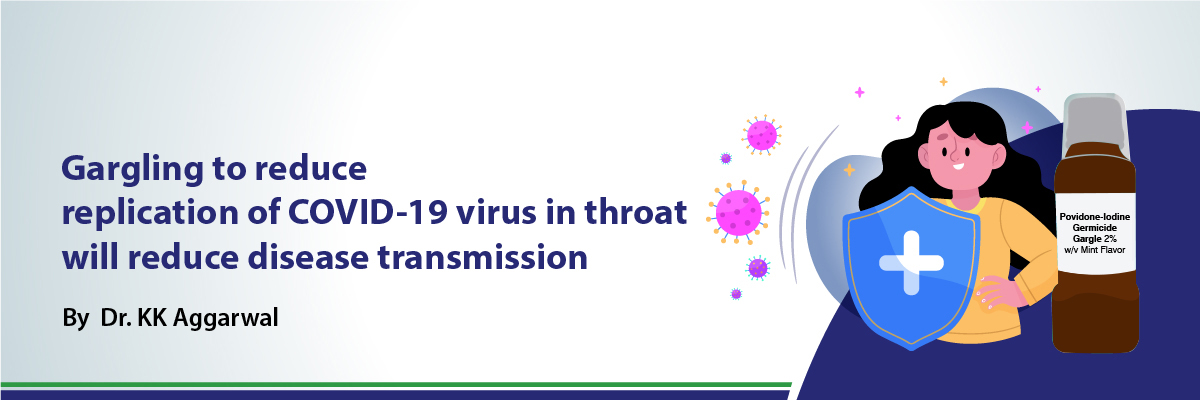

Gargling to Reduce Replication of COVID-19 Virus in Throat will Reduce Disease Transmission
COVID-19, caused by the SARS-CoV-2 virus, is a highly contagious disease. The SARS-CoV-2 virus is transmitted primarily through infected respiratory secretions as droplets exhaled when an infected person coughs, sneezes, talks or sings.1 Infections occur mainly through exposure to these respiratory droplets when a person is in close contact with someone who has COVID-19. 2 The infected persons are most infectious just before they develop symptoms and early in their illness. People who have severe infection can be infectious for longer periods.3
SARS-CoV-2 shows tropism for the throat tissue. 4 Corroborating this, a virological study has shown that the SARS-CoV-2 virus actively replicates and is shed in the upper respiratory tract tissues early in the course of infection. Very high pharyngeal virus shedding was observed in the first week of symptoms, with a peak of 7.11 × 108 RNA copies per throat swab by Day 4 of the illness.5
The micro-organisms gain access to the lower respiratory tract through the upper respiratory tract (nose and mouth). While COVID-19 is mild in most cases, pneumonia may occur in some and is a severe complication of the infection. The lung function may take months to return to normal even after recovery.
Given the propensity of the SARS-CoV-2 virus to replicate in the throat, which serves as a reservoir for droplet transmission, a strategy that may reduce this replication and thereby viral shedding will reduce transmission of virus and help control the pandemic, especially in view of the fact that currently there are no specific antiviral drugs or vaccines against COVID-19.
Gargling is routinely done in upper respiratory infections (URIs). Its effectiveness in preventing URIs among healthy people has been shown in a randomized controlled trial. 6 Researchers from Chang Gung University College of Medicine in Taiwan have suggested that gargling may be a beneficial practice in the COVID-19 pandemic as well.4 Although it does not eradicate the virus from the throat; but, by decreasing the viral load, gargling may reduce severity of infection and also reduce risk of community transmission by reducing the amount of virus exhaled.7
Povidone-iodine (PVP-I) is a commonly used antiseptic, with an established broad-spectrum antimicrobial activity, multimodal action, lack of reported resistance and an excellent safety profile. PVP-I mouthwashes and gargles significantly reduce viral load in the oral cavity and the oropharynx.8
In vitro studies have shown significant virucidal activity of PVP-I against Sudden Acute Respiratory Syndrome (SARS) and Middle East Respiratory Syndrome (MERS) coronaviruses9 as well as SARS-CoV-2. 4,10,11 The virucidal activity is evident as early as 15 seconds.4
An open-labeled, randomized study was conducted in a tertiary hospital in Malaysia to investigate the efficacy of regular gargling to eliminate SARS-CoV-2 in the throat and nasopharynx. This preprint study compared the effect of 30 seconds, thrice-daily gargling using 1% PVP-I, essential oils and tap water on SARS-CoV-2 viral clearance among patients with confirmed Stage 1 Covid-19 (asymptomatic state - first two days of infection).12
The study found that gargling with PVP-I resulted in 100% viral clearance as early as 4 days after the intervention (equivalent to 5 to 6 days after diagnosis), whereas gargling with essential oils achieved 80% viral clearance, tap water led to 20% viral clearance, while the control group (with no intervention) had 0% viral clearance. Early viral clearance is very critical as the disease is highly infectious at the early stage. Hence, the study authors concluded that PVP-I has great potential to be part of the treatment and management of Stage 1 COVID-19.
While wearing a face mask, frequent hand washing and physical distancing are the usually recommended protective measures, inclusion of gargling with an antiseptic such as PVP-I as a hygiene practice will only boost the preventive measures to curb the spread of infection. The favorable effect of gargling is through removal of the pharyngeal protease, which has a role to play in the replication of coronavirus.13
References
- Transmission of SARS-CoV-2: implications for infection prevention precautions, Scientific Brief, WHO, 9 July 2020.
- How Covid-19 spreads, CDC, October 5, 2020.
- Q&As. Coronavirus disease (COVID-19): How is it transmitted? 20 October 2020, WHO.
- Tsai C, et al. Possible beneficial role of throat gargling in the coronavirus disease pandemic. Public Health. 2020;185:45-6.
- Wölfel R, et al. Virological assessment of hospitalized patients with COVID-2019. Nature. 2020 May;581(7809):465-9.
- Satomura K, et al. Prevention of upper respiratory tract infections by gargling: a randomized trial. Am J Prev Med. 2005;29:302-7.
- Herrera D, et al. Is the oral cavity relevant in SARS-CoV-2 pandemic? Clin Oral Investig. 2020;24(8):2925-30.
- Eggers M. Infectious disease management and control with Povidone Iodine. Infect Dis Ther. 2019;8(4):581-93.
- Ricardo AP Persaud. Povidone-iodine may be the “silver bullet” in the prevention and control of Covid-19 infection, based on new scientific data. On J Otolaryngol & Rhinol. 2020;3(1).
- Anderson DE, et al. Povidone-iodine demonstrates rapid in vitro virucidal activity against SARS-CoV-2, the virus causing COVID-19 disease. Infect Dis Ther. 2020:9(3):669-75.
- Bidra AS, et al. Rapid in-vitro inactivation of severe acute respiratory syndrome coronavirus 2 (SARS-CoV-2) using povidone-iodine oral antiseptic rinse. J Prosthodont. 2020;29(6):529-33.
- Mohamed NA, et al. Early viral clearance among covid-19 patients when gargling with povidone-iodine and essential oils – a clinical trial. MedRxiv. September 9, 2020,
- Kitamura T, et al. Can we prevent influenza-like illnesses by gargling? Intern Med. 2007;46(18):1623-4.
Related FAQs
Importance of Oral Hygiene for Overall Health
Patient's Guide on Common Oral Infections and Transmission
How To Prevent Yourself And Your Family From COVID -19 Infection
Gargling Is A Potential Preventive Strategy To Reduce COVID-19 Transmission
Prevention of COVID-19
Do's and Don'ts during COVID times
4 Lines of Defence Can Keep You Safe
Social Engineering In Prevention Of COVID-19
5 Tips to Stay Safe OR 5 Tips to Protect Yourself
Povidone-Iodine For Oral Hygiene During The Pandemic

